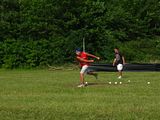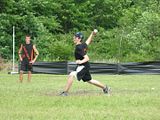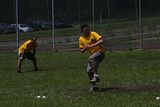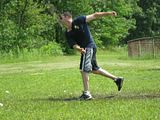 | Coffee Time | |
| by Carl Coffee |
My first "Coffee Time" article for The Skinny will focus on the most important player on any wiffleball team: the pitcher. From when we first started hosting wiffleball tournaments in 2005 to this past year, every winning team road the coattails of a hot pitcher. David Negele, Joe Emery, Eric Falletich, Brian Constanti, and Brandon Corbett all were the reasons why their teams won their respective tournaments. We currently have six teams signed up for our inaugural season, so this will rank the top 5 pitchers in the league from those teams. I am going to use past stats, personal experience hitting off of these pitchers, and future potential. Enjoy!
#5 Dylan Braden [Git r Done]
Dylan of Git r Done is one the youngest and most talented players in the league. His team shocked everyone in the 2010 Flag-a-Palooza by reaching the finals. This young gun was the reason for their success that day. He won 3 games for his team with a 2.83 ERA while striking out 36 batters, which included 4 first pitch strike outs. Dylan is only going to get better this season and in my opinion is a potential MVP. Although he made this list at #5, he may not even pitch much this season. Teammate Dennis Pearson appears to be his team’s number one pitcher. If that's the case, then Dylan will easily be the best number two pitcher in the league.
#4 Maclin Malloy [Westside Warriors]
Maclin Malloy is next on the list at four, but ranks first in the league for coolest name. When the Warriors made their debut at the Flag-a-Palooza last year it appeared they used trial and error to find their number one pitcher. After watching Whelan, Woods, and Shore all try their hand, Malloy took the mound and ran away with the job. He pitched 21 innings that day: winning 3 games, striking out 26, including 4 first-pitch K's, and had a 1.43 ERA. Malloy wasn't able to play at the Hoppes September tournament, so I haven't been able to see that much of him, but his stats do not lie. I expect big things from him this summer.
#3 Chad Hoppe [Wiffling DeLoppes]
Although Chad Hoppe ranks in at #3, in my opinion he is the poster boy for pitchers in our league. There isn't a team out there who depends more on one player. With that said, I have to rank him here because in the three tournaments his team has played in he hasn't been to a championship game. The one thing that is stopping Chad from being #1 is run support. When you see Chad on the mound, you think to yourself "I can hit this guy", then before you know it he hangs a curveball on the first pitch that somehow hits the corner and you are out. In the three tournaments Chad has played in he has put up some incredible stats. His three ERA's have been (1.54, 1.56, and 1.38) and he has a combined 98 Ks! I've gone to bat against Chad many times and you definitely have to be on your toes. Along with his pitching he is also one of the best defensive pitchers in the league, and always knows where to be when the ball is in play. I may regret putting him at #3...
#2 Brandon Corbett [Flying Squirrels]
I've been playing wiffleball with and against Brandon now for over six years and it is crazy to see him dominate at pitching like this. When we first started playing competitive wiffleball in 2005, this guy wasn't even a pitcher! It wasn't until 2009 when we put together a team and realized none of us were pitchers that he jumped on the mound and quickly learned the role. You can easily notice the improvement Brandon has made if you look at the stats from the three tournaments he has pitched in. First case in point, ERA: (2.94, 1.11, 0.26). Second case in point, Ks: (13, 17, 20). Third and final case in point, Wins: (1, 2, 4). In every single tournament Brandon has gotten better. At the Hoppe's September tournament he only gave up one earned run in 19 innings! Getting about one per inning he doesn't rack up the strike outs like Chad does, but as his short stop I know what he does better than anyone in the league... get ground ball outs. Brandon is a very accurate pitcher which means the batters take a lot of defensive swings against him. Defensive swings equal ground balls, which equal easy outs. It is going to be tough to improve on his last pitching performance at the Hoppes, but I wouldn't bet against him!
#1 Brian Constanti [Newport Ass Kickers]
I had a tough time deciding whether or not to rank a player at #1 who has only pitched in one tournament over two guys (Chad, Brandon) who have pitched in three. I thought if over and then I reread Brian's stats from the 2010 Flag-a-Palooza tournament; at that point my decision was easy. Much like the Warriors, Brian and team Kickass did not know who their pitcher would be at the start of the day. Once Brian took the hill, they found their guy. Brian won an amazing 5 games for his team that day, and only allowed 2 runs in 29 innings (0.34 ERA). His fastball had so much late movement, it was virtually unhittable. Brian struck out 42 batters in the tournament and easily won the MVP award. When I found out that his team was joining our league, (Newport Ass Kickers) it got me very excited. Having the chance to bat against great pitchers is an exciting challenge, and there is nothing more satisfying than getting a big hit off them or beating them on the field. If he can continue to pitch like he did in the Flag-a-Palooza, Brian and his team will be a favorite to win it all.
I hope you enjoyed my rankings. When the season gets underway and we start playing some games, I will adjust the rankings every month or so. I look forward to hitting against all of you!
-
Carl Coffee, 18, SS
Flying Squirrels Captain
Commissioner of WSEM




















